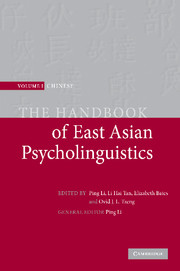Book contents
- Frontmatter
- Contents
- List of figures
- Notes on contributors
- Preface
- Introduction: new frontiers in Chinese psycholinguistics
- Part I Language acquisition
- 1 Actions and results in the acquisition of Cantonese verbs
- 2 Chinese children's knowledge of the Binding Principles
- 3 Chinese classifiers: their use and acquisition
- 4 Child language acquisition of temporality in Mandarin Chinese
- 5 Second language acquisition by native Chinese speakers
- 6 Making explicit children's implicit epilanguage in learning to read Chinese
- 7 Emergent literacy skills in Chinese
- 8 Basic syntactic categories in early language development
- 9 Growth of orthography-phonology knowledge in the Chinese writing system
- 10 Interaction of biological and environmental factors in phonological learning
- 11 The importance of verbs in Chinese
- 12 Grammar acquisition via parameter setting
- 13 Early bilingual acquisition in the Chinese context
- Part II Language processing
- Part III Language and the brain
- Epilogue: a tribute to Elizabeth Bates
- References
- Name index
- Subject index
6 - Making explicit children's implicit epilanguage in learning to read Chinese
Published online by Cambridge University Press: 05 June 2012
- Frontmatter
- Contents
- List of figures
- Notes on contributors
- Preface
- Introduction: new frontiers in Chinese psycholinguistics
- Part I Language acquisition
- 1 Actions and results in the acquisition of Cantonese verbs
- 2 Chinese children's knowledge of the Binding Principles
- 3 Chinese classifiers: their use and acquisition
- 4 Child language acquisition of temporality in Mandarin Chinese
- 5 Second language acquisition by native Chinese speakers
- 6 Making explicit children's implicit epilanguage in learning to read Chinese
- 7 Emergent literacy skills in Chinese
- 8 Basic syntactic categories in early language development
- 9 Growth of orthography-phonology knowledge in the Chinese writing system
- 10 Interaction of biological and environmental factors in phonological learning
- 11 The importance of verbs in Chinese
- 12 Grammar acquisition via parameter setting
- 13 Early bilingual acquisition in the Chinese context
- Part II Language processing
- Part III Language and the brain
- Epilogue: a tribute to Elizabeth Bates
- References
- Name index
- Subject index
Summary
Learning to read is primarily a language process and basic language skills account for a considerable amount of individual variation. Children come to reading with what Gombert (1992) and others have called epilanguage or implicit awareness of metalinguistic tasks such as rhymes and language games. They need to be taught systematically to make explicit this implicit metalinguistic awareness to access print. There is now strong evidence that phonological information-processing skills – such as phonological awareness of sublexical units of onsets, rimes, and phonemes; phonological memory; and verbal information processing speed – are critical to learning to read alphabetic writing systems (Adams, 1990; Goswami, 2002; Goswami & Bryant, 1990; Høien et al., 1995; Hulme, 2002; Hulme et al., 2002; Share, 1995; Wagner & Torgesen, 1987; Wagner et al., 1997). In this chapter I will argue that similar phonological processing skills are as important in learning to read morphosyllabic Chinese (DeFrancis, 1989) as in learning to read English. Whereas it is the metalinguistic awareness of “small units” of phonemes that is important in learning to read alphabetic systems such as English, it is the epilinguistic awareness of the “large units” of syllables and onsets and rimes that is critical to reading Chinese. This epilinguistic awareness of sublexical units also includes suprasegmental elements of tones, which have special significance in reading Chinese. After reviewing current literature, I will present some recent data to examine the effects of phonological processing on reading Chinese words in Putonghua-speaking Chinese children in Beijing to support my argument.
- Type
- Chapter
- Information
- The Handbook of East Asian Psycholinguistics , pp. 70 - 80Publisher: Cambridge University PressPrint publication year: 2006

